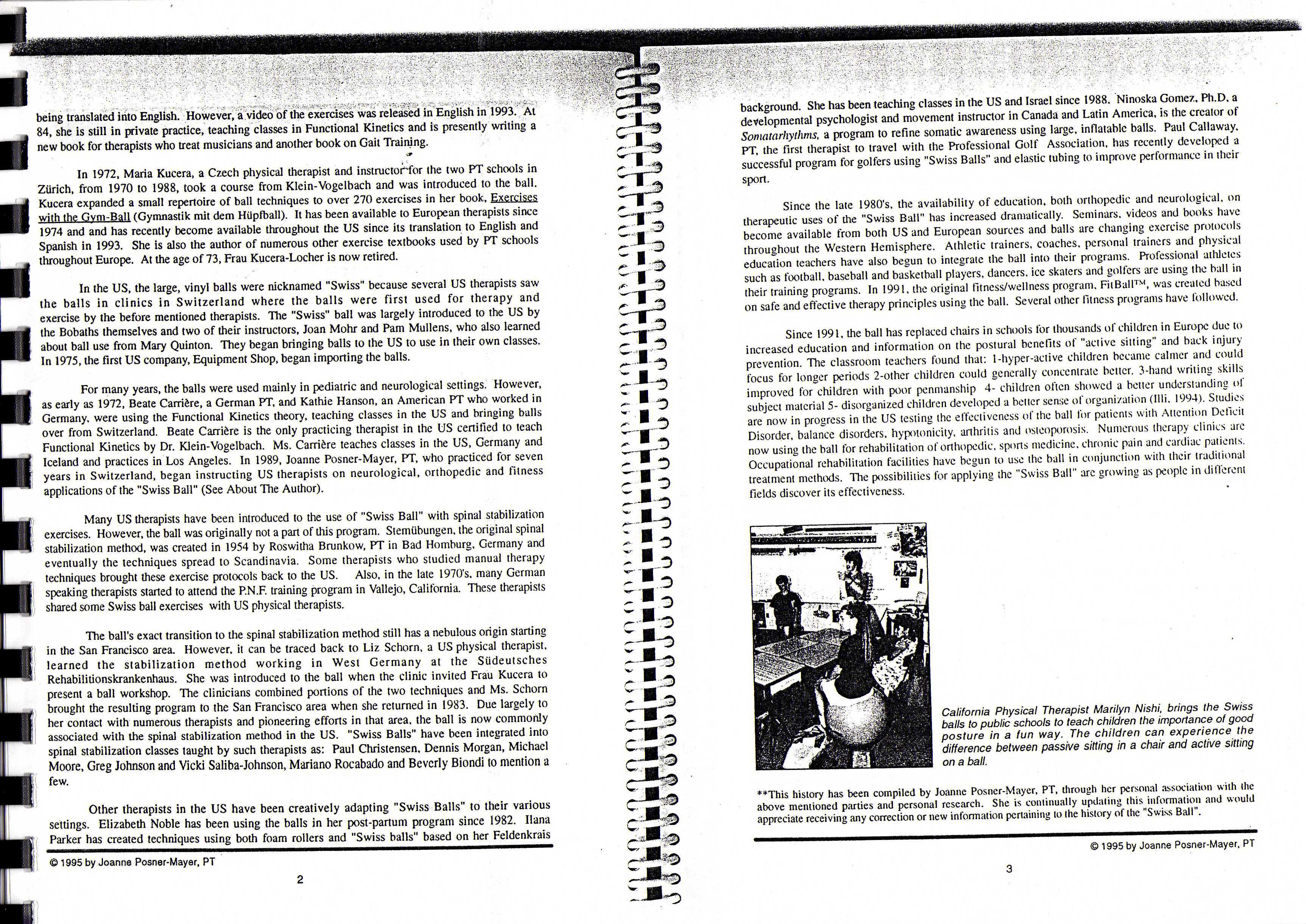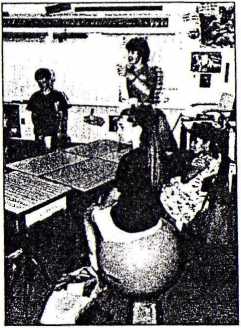img015


being translated into English. However, a video of the exercises was released in English in 1993. At 84, she is still in private practice, teaching classes in Functional Kinetics and is presently writing a new book for therapists who treat musicians and another book on Gaił Training.
In 1972, Maria Kucera, a Czech physical therapist and instructorfor the two PT schools in Ziirich, from 1970 to 1988, took a course ffom Klein-Vogelbach and was introduced to the bali. Kucera expanded a smali repertoire of bali techniąues to over 270 exercises in her book, Exereises with the Gvm-Ball (Gymnastik mit dem Hiipfball). It has been available to European therapists sińce 1974 and and has recently become available throughout the US sińce its translation to English and Spanish in 1993. She is also the author of numerous other exercise textbooks used by PT schools throughout Europę. At the age of 73, Frau Kucera-Locher is now retired.
In the US, the large, vinyl balls were nicknamed "Swiss" because several US therapists saw the balls in dinics in Switzerland where the balls were first used for therapy and exercise by the before mentioned therapists. The "Swiss" bali was largely introduced to the US by the Bobaths themseWes and two of their instructors, Joan Mohr and Pam Mullens, who also learned about bali use from Mary Quinton. They began bringing balls to the US to use in their own classes. In 1975, the first US company, Equipment Shop, began importing the balls.
For many years, the balls were used ntainly in pediatrie and neurological settings. However, as early as 1972, Beate CarriSre, a German PT, and Kathie Hanson, an American PT who worked in Germany, were using the Functional Kinetics theory, teaching classes in the US and bringing balls over from Switzerland. Beate Carriśre is the only practicing therapist in the US certified to teach Functional Kinetics by Dr. Klein-Vogelbach. Ms. Carrićre teaches classes in the US, Germany and Iceland and practices in Los Angeles. In 1989, Joannę Posner-Mayer, PT, who practiced for seven years in Switzerland, began instructing US therapists on neurological, orthopedic and fitness applications of the "Swiss Bali" (See About The Author).
Many US therapists have been introduced to the use of "Swiss Bali" with spinał stabilization exercises. However, the bali was originally not a part of this program. Stemiibungen, the original spinał stabilization method, was created in 1954 by Roswitha Brunkow, PT in Bad Homburg. Germany and eventually the techniques spread to Scandinavia. Some therapists who studied manuał therapy techniąues brought these exercise protocols back to the US. Also, in the late 1970's. many German speaking therapists started to attend the P.N.F. training program in Vallejo, California. These therapists shared some Swiss bali exercises with US physical therapists.
The ball's exact transition to the spinał stabilization method still has a nebulous origin starting in the San Francisco area. However. it can be traced back to Liz Schorn, a US physical therapist. learned the stabilization method working in West Germany at the Siideutsches Rehabilitionskrankenhaus. She was introduced to the bali when the clinic invited Frau Kucera to present a bali workshop. The clinicians combined portions of the two techniąues and Ms. Schorn brought the resulting program to the San Francisco area when she retumed in 1983. Due largely to her contact with numerous therapists and pioneering efforts in that area. the bali is now commonly associated with the spinał stabilization method in the US. "Swiss Balls" have been integrated into spinał stabilization classes taught by such therapists as: Paul Christensen. Dennis Morgan, Michacl Moore, Greg Johnson and Vicki Saliba-Johnson, Mariano Rocabado and Bevcrly Biondi 10 ntention a few.
Other therapists in the US have been creatively adapting "Swiss Balls" to their various settings. Elizabeth Noble has been using the balls in her post-partum program sińce 1982. liana Parker has created techniąues using both foam rollers and "Swiss balls" based on her Feldenkrais background. She has been teaching classes in the US and Israel sińce 1988. Ninoska Gomez, Ph.D. a developmentaI psychologist and movement instructor in Canada and Latin America, is the crcalor of Somaiarhyihms, a program to refine somatic awareness using large, inflatablc balls. Paul Callaway, PT, the first therapist to trave! with the Professional Golf Associalion. has recenlly developed a successful program for golfers using "Swiss Balls" and elastic tubing to intprove performance in their sport.
Since the lale 1980's, the availability of education. bolh orthopedic and neurological, on therapeutic uses of the "Swiss Bali" has increased dramalically. Seminars. videos and books have become available from both US and European sources and balls are changing exerci.se protocols throughout the Western Hemisphere. Athletic trainers, coaches. pcrsonal trainers and physical education teachers have also begun to integrale the bali into their programs. Professional athletes such as football, baseball and basketball players, dancers. ice skaters and golfers are using the bali in their training programs. In 1991, the original fitness/wellness program. FitBall™, was created based on safe and effective therapy principles using the bali. Several other fitness programs have followed.
Since 1991, the bali has replaced chairs in schools for thousands of children in Europę due to increased education and information on the postural benefits of "aclive silting" and back injury prevention. The classroont teachers found that: l-hyper-active children bccame calnier and could focus for longer periods 2-other children could generally concenlrate beltcr. 3-hand wriling skills intproved for children with poor penmanship 4- children often showed a better understandina ol subject materiał 5- disorganized children developed a better sense of organization (liii. 1994). Studies are now in progress in the US testing the effectiveness of the bali for patients with Attention Deficit Disorder, balance disorders. hypotonicily. anhritis and osteoporosis. Numcrous therapy dinics are now using the bali for rehabilitation of orthopedic. sports ntedicine. chronic pain and cardiac patients. Occupational rehabilitation facilities havc begun to use the bali in eonjunction with their tradilional treatment methods. Tire possibilities for applying the "Swiss Bali" are growing as peopic in dilTerem fields discover its effectivcness.

California Physical Therapist Marilyn Nishi, brings the Swiss balls to public schools to teach children the importance of good posturę in a fun way. The children can experience the dilference between passive sitting in a chair and active sitting on a bali.
*łThis history has been compiled by Joannę Posncr-Maycr, PT, through her persona! associalion with the above mentioned pariies and persona! rescarch. She is continually updaling this information and would appreciate receiving any correction or ttew information pertaining to the history of the “Swiss Bali".
© 1995 by Joannę Posner-Mayer, PT
Wyszukiwarka
Podobne podstrony:
307 (31) 279 Buttons other side of the garment - was recognised in the pieces of 14th-century clothi
interactive naturę of the learning process; the ku4hańga or bat-tamiz initiate (which translate into
Pn 12:11 o Q O O O Qg? GATUNKI^ English Literaturę Epic poetry, Greek --Translations into Engli
Irregular verbs 3. Good luck © Name Score ..A. % .i.*?..... Mark .. !l. h Translate into English the
Irregular verbs 4. Good luck © Name . Score* 41 *5 Mark c Translate into English the following irreg
EXERCISE E. Translate into English. 1. 15 marca 56-letni mężczyzna został przyjęty
img501 Task 5 Read the following sentences and translate into English the phrases in the brackets. T
DSC00568 VOCABULARY & GRAMMAR 1. Translate into English a) złodziej sklepowy -
DSC00576 (4) 9. Translate into English a. c.d.e. Nie wierzę, że te rady będą pomocne, i 4— Te wałizk
DSC00577 (4) 10. tupłain tho diffcrcncc bctwMn muęh, piany, fow. Ultltó- Give cxsntplM 11. Translate
00193 ?7fc11aa847338bb01b7ea0e7ff2d66 195Strategies for Statistical Monitoring of Integral Control
S5002134 96 not be distinguished morę predsely, however, because of the fragmentary naturę of the fi
więcej podobnych podstron